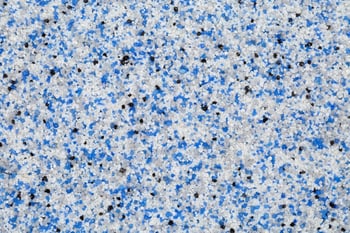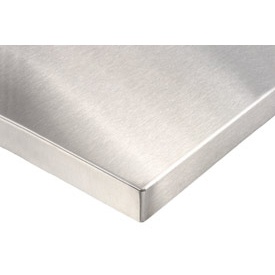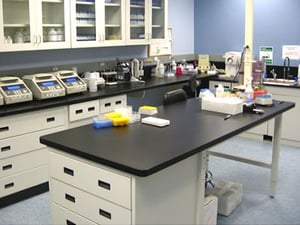Each component of a workbench serves an essential role, but choosing which countertop to put on top of the workbench is perhaps one of the most significant decisions you’ll have to make. That is because it must be able to withstand the harsh conditions found in your workspace.
So, which industrial workbench commercial grade countertop is best? The answer depends on a number of factors, including the application of your work, your budget and common conditions that may warrant one material over another. In general, materials like epoxy resin and phenolic resin are among the best materials for workspaces that have extreme conditions.
However, which industrial workbench countertop is best for you may differ from what is best for another laboratory or manufacturing company.
Let’s take a closer look at some of the most popular countertops for industrial workbenches so that you can evaluate which material is best for your space.
Epoxy Resin
Epoxy resin is made from a mixture of materials which is then cured as a solid product. It is very durable and non-porous, making it an excellent choice in facilities where harsh and extreme conditions exist. Many labs choose to use epoxy resin around sinks and where heavy moisture exists.
non-porous, making it an excellent choice in facilities where harsh and extreme conditions exist. Many labs choose to use epoxy resin around sinks and where heavy moisture exists.
Epoxy resin’s greatest advantages:
- Flame retardant
- Can withstand continuous heat exposure above 350 degrees F
- Highly resistant to bacteria, fungus, corrosion, chemicals, water, moisture and scratches
- Holds up well against impact and stress fractures
- Resistant to the most aggressive chemicals and easy to clean
Epoxy resin’s greatest advantages:
- Its cost … epoxy resin is one of the most expensive materials on the market, possibly putting it beyond your budget
Bottom line: Epoxy resin offers several advantages that make this material a great choice for harsh environments. Although it has a high price tag when compared to other materials, epoxy resin might make the most sense for environments like industrial testing, microbiology, research and development labs, medical facilities and any other workspaces that use harsh chemicals, open flames and instruments that create extreme heat.
Phenolic Resin
Phenolic resin countertops are manufactured by layering natural kraft paper that has been saturated with phenolic resin and processed under high heat. The result is one solid, lightweight countertop.
Phenolic resin itself is a compound that combines phenol and formaldehyde, creating large networks of permanently bonded molecules. Depending on the balance between phenol and formaldehyde, and whether the catalyst is an acid or a base, the phenol formaldehyde resin properties may vary.
Phenolic resin’s greatest advantages:
- Can withstand continuous heat exposure up to 350 degrees F
- Highly resistant to bacteria, fungus, chemicals, moisture and scratches
- Moderately to highly resistant to corrosion
- Holds up well against impact and stress fractures
- Mid-priced when compared to other materials, making it a more affordable option with many of the same benefits as epoxy resin
Phenolic resin’s greatest disadvantages:
- Not flame retardant
Bottom line: Because phenolic resin is not flame retardant, this material might not be the best choice for spaces where open flames are routinely used. It’s an excellent choice, however, for spaces like education, microbiology, and research and development labs, as well as industrial testing facilities and hospitals.
Stainless Steel
Stainless steel countertops are made of low carbon steel that is made up of chromium and nickel. 
Stainless steel’s greatest advantages:
- Can withstand heat exposure above 1500 degrees F
- Non-porous, so no liquids or substances can penetrate the material
- Highly resistant to bacteria, fungus and mold because of its non-porous feature
- Moderately resistant to chemicals and corrosion
Stainless steel’s greatest disadvantages:
- Discoloration may form at prolonged high temperatures
- Low resistance to scratches and can dent easily on impact
- High-priced when compared to other materials (only epoxy resin is typically more expensive)
Bottom line: The greatest advantages of stainless steel countertops are their ability to withstand heat exposure above 1500 degrees F and their non-porous design. This makes this material ideal for clean rooms, food testing facilities, pharmaceutical labs and other facilities where test results depend on non-contamination or the use of high heat.
Chemical Resistant Laminate
Chemical resistant laminate countertops are made by applying a melamine resin over decorative surface paper. This is then bonded to a core of kraft papers impregnated with phenolic resin.
Chemical resistant laminate’s greatest advantages:
- Highly resistant to chemicals
- Able to withstand heat exposure up to 275 degrees F
- Available in different designer looks
- Mid-price when compared to other materials
Chemical resistant laminate’s greatest disadvantages:
- Low resistance to bacteria, corrosion, fungus, water, moisture and scratches
Bottom line: Where chemical resistant laminate countertops aren’t right for every type of lab environment, they can be a great choice for dry environments such as dental, pathology and photography labs, as well as facilities that test products.
HPL Laminate
HPL, of high pressure laminate, is made by applying a melamine resin over decorative surface paper. This is then bonded to a core of kraft papers impregnated with phenolic resin. This creates a decorative work surface that is functional for non-extreme environments.
then bonded to a core of kraft papers impregnated with phenolic resin. This creates a decorative work surface that is functional for non-extreme environments.
HPL’s greatest advantages:
- Can withstand heat exposure up to 275 degrees F
- Available in different designer looks
- Lower priced when compared to other materials
HPL’s greatest disadvantages:
- Low resistance to bacteria, chemicals, corrosion, fungus, water, moisture and scratches
Bottom line: While similar to chemical resistant laminate in looks and other features, HPL does not offer adequate resistance to chemicals. This is why you’ll pay a lower price for this type of material than chemical resistant laminate. However, this is still a good choice for many dry environments, such as product testing and technology labs.
ESD Laminate
ESD laminate surfaces are typically found in labs that manufacture electronic devices and need protection against electrostatic discharge. An ESD laminate top features an embedded carbon layer, which dissipates the damaging static.
ESD laminate’s greatest advantages:
- Protection against electrostatic discharge
- Highly resistant to staining and chemicals that include acetone, gasoline and 10% ammonium solutions
ESD laminate’s greatest disadvantages:
- More costly than another laminate product (expect to pay about 15 to 30% more for an ESD product over a non-ESD product)
- Can scratch easily, so cleaning supplies like steel wool should be avoided
Bottom line: ESD laminate can help prevent electrostatic discharge, which can be costly and dangerous. This material is typically found in specialized environments that focus on areas like electronic assembly and aerospace manufacturing.
Solid Surface Countertops
Solid surface countertops are made from a non-porous, homogeneous material that maintains the same composition throughout the countertop. Solid surface is similar in that it is often made from acrylic or polyester resins and features a filler material.
Solid surface’s greatest advantages:
- Nonporous surface, which keeps bacteria and mildew away
- Highly resistant to stains
- Aesthetically pleasing since they generally feature invisible seams
- Higher level of durability because the material is homogeneous
- Minor damage can be easily fixed with sandpaper or an orbital sander
Solid surface’s greatest disadvantages:
- Not heat resistant, and can crack or discolor when in contact with high heat
- Low resistance to scratches
- High price tag when compared to other materials
Bottom line: Because solid surface countertops are softer than many other materials, they can be molded and shaped in several ways under heat and pressure. They can also be designed to imitate the look of other materials like granite and marble. This makes solid surface countertops an attractive choice. Because of its low porosity, this material also works well in environments that require cleaner, more sanitary workspaces, such as hygienic areas like doctor’s offices and dental offices.
A Long-Term Investment
No matter which countertop you choose, it’s important to think of it as a long-term investment. When deciding, take into account any current applications your workspace performs, as well as any future applications that may be on the horizon. This will save you from costly replacements and downtime.
The best countertop manufacturers will work with you to help you weigh your options, to customize your preferences based on your needs, and to ensure you receive your investment in a timely manner.


